The Town Hall and Public Offices are situated in Hamilton-street. They were
planned by James Watt in 1705, and finished the following year. In order to
have the benefit of the Hall for their meetings, the Lodge, Greenock
Mountstuart Kilwhining, No: 11, advanced £30 to assist in the building. This
building has been altered since its first erection; having had on the
ground-floor, where are now shops, a prison and the Council Chambers. n
frontt of both of these used to be placed four field- pieces, made of brass;
and here a sentinel paraded, in consequence of the Guard-house being then
immediately behind. This place has been for some time used as the Police
Office; and its immediate vicinity to the Court hall makes it very
convenient. In the Hall, which is spacious, there are two excellent
paintings of King George the Third and his Queen. The rest of the apartments
are occupied by the Town Clerk, Procurator-Fiscal, and the Town Treasurer.
Previous to the erection of this building, and in 1753, the Magistrates and
Council met in a shade in William-street, where Messrs. Macfie, Lindsay &
Co.'s grocery is situated: here also the first post-office was kept, and the
fire-engine, which arrived in Greenock in 1753, was placed, under the charge
of a superintendant, with a salary of :30s. annually. It is to be regretted
that the council records go no farther back than 1749, the early part of
this chronicle having been torn out by some sacrilegious hand. It bears
entire, however, the following liberal Charter, granted by Sir John Schaw in
1751 :-
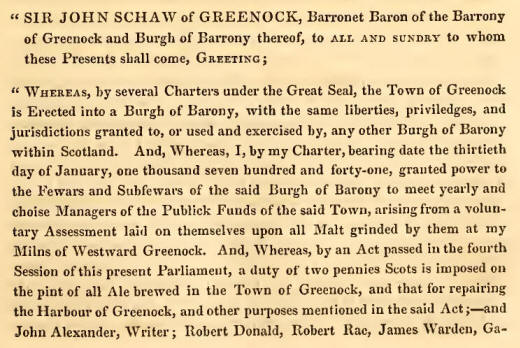
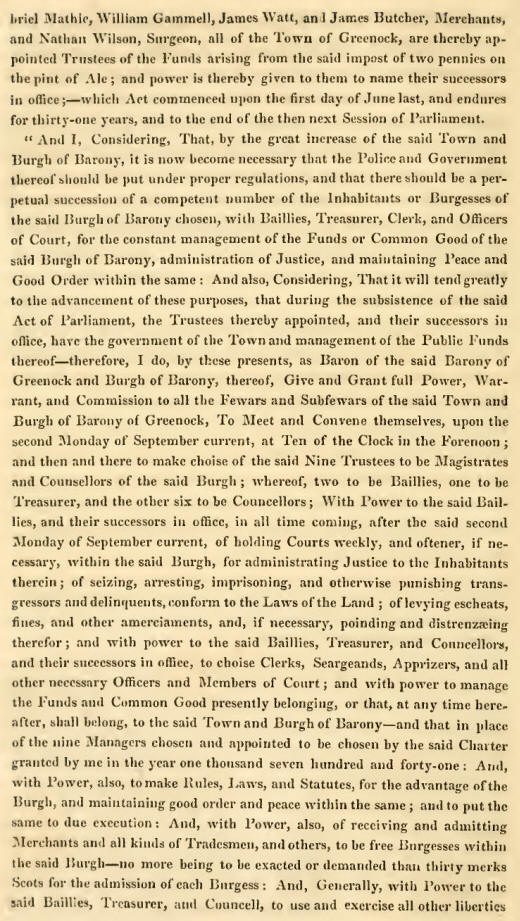
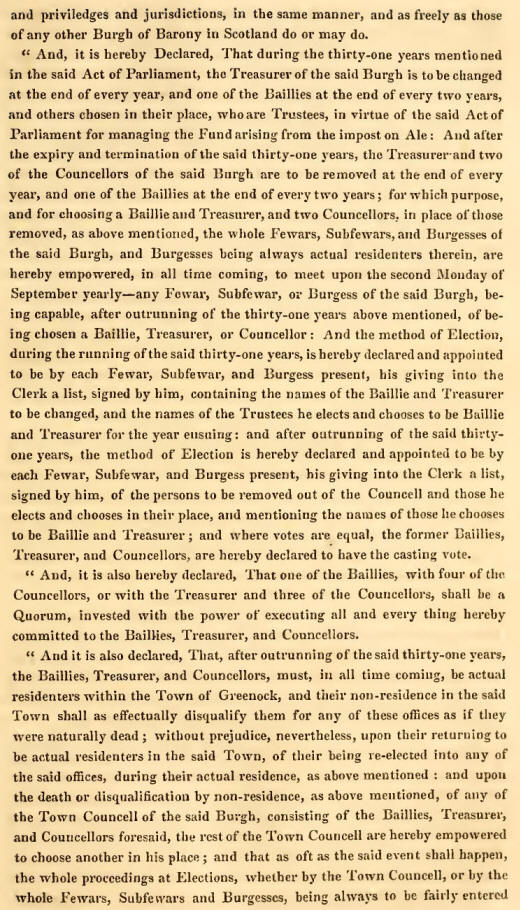
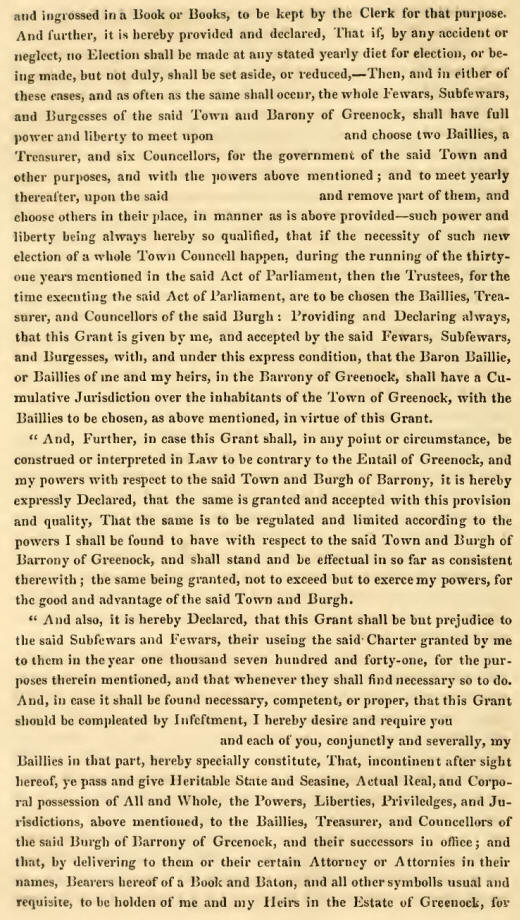
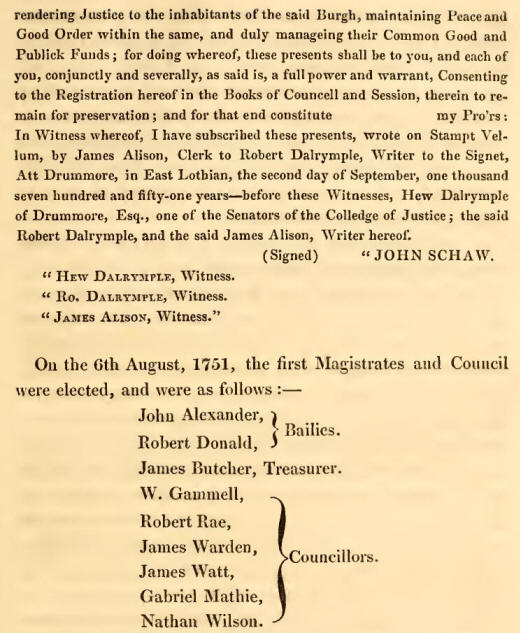
The first Guard-house was at the foot of Cowgate, and continued till removed
to the Town Hall; and the place more recently used for this purpose is
situated in the lane leading from the Square to the Green Market.
A Dispensary for the benefit of the Sick Poor was established in 1801. The
house appropriated for it was situated in Manse-lane; it was afterwards
removed to the ground-floor of a house in Cathcart-street, the site of which
is occupied with part of the Exchange Buildings. The sum at first subscribed
for the establishment of this charity, and for its support for the first
year, was £131 3s. From the 1st July, 1801, 177 patients were admitted; and
from its commencement, on until united with the Hospital in 1809, there were
1715. By the constitution, the poor, when sick at home, and unable to
attend, were visited by one of the surgeons daily; and the medicines
prescribed were prepared by an apothecary, who, with the medical attendants,
four in number, were elected annually by the subscribers. Surgical
instruments, with apparatus used for the recovery of drowned persons,
belonged to the Dispensary.
In 1800 a contagious fever became very prevalent, and was traced to the
seamen of a prize-vessel brought into harbour. The inmates of lodging-houses
first caught the infection, and from them it soon extended to other
families. The alarm was great; hut, by means of the Dispensary, much misery
was relieved, and the progress of the disease finally arrested. On 23d of
October, 1800, Dr. Speirs, one of the surgeons of the Dispensary, directed
the attention of the committee to the establishing an Hospital, or
Fever-house, where the poor would be removed from their own uncomfortable
dwellings, not only for their own sakes, but for the purpose of checking
infection. At this meeting, a sub-committee was appointed to inquire into
the expense of such an establishment; and on 2d of December they gave in
their report, with one from Dr. Colquhoun, ''As to the rise and progress of
the Infectious Fever prevailing;" and another by Dr. Speirs, ''On the
subject of the present and other Epidemical Diseases." On 3d January, 1807,
it was resolved, that an Hospital or Infirmary be erected, and subscriptions
were opened for carrying the object into effect. On the 23rd February, the
first meeting of subscribers was held in the Tontine, when Alexander Dunlop,
Esq., Banker, informed the meeting, that Sir John Shaw Stewart had offered
forty falls of ground for the site of the building. A plan was submitted by
Mr. Aird, Master of Works; and on 28th September, 1808, Mr. George
Dempster's estimate, amounting to £1150, was agreed to. The subscriptions
amounted to £2357 11 7. It may be worth remarking, that many individuals
excused themselves from subscribing to this necessary institution, by
saying, that a Bridewell was more wanted." One of the committee, who was
zealous in cause, and at the same time jocular, would not let them get off
with this excuse, but at once said, both were intended;" and for this
reason, from the subscriptions £500 was set apart for building at Bridewell,
which was the foundation of the fund for this erection. At a general
meeting, on 3d May, 1809, rules, &c., were adopted for the management of the
charity; office-bearers were appointed; the furniture, &c., removed from the
Dispensary, which now merged into that of the Hospital. At the time the
house was opened, the cost amounted to £1504 7s., and on 14th June the first
patient was admitted. From that Period till 1st May, 1810, 51 patients were
admitted, and 149 received benefit as outpatients.
The airing-ground being found rather limited, application was made to the
late Sir Michael Shaw Stewart, for a small addition. He, in the most liberal
manner, on looking at the spot, desired his factor to make over to the
trustees the whole piece of ground, from the original house to the street,
being much more than was asked.
The Hospital, since its establishment, has continued to rise in usefulness;
and there is no doubt but it will keep pace, in that respect, with the
increase of trade and population. It has been found necessary to extend its
accommodation, by adding two wings to it and this will be soon be completed
at about £900; a sum which was at once cheerfully subscribed, and rapidly
carried into effect. This must be always considered as the first of public
charities in and well deserves the support of the public. Much
responsibility attaches to the managers; and it is to be trusted that a
proper and enlightened feeling will ever actuate them in the discharge of
their duty. Their motto ever should be, "We are the guardians of the Sick
Poor."
The appearance of the Hospital, since the additions were made to it, is
rather elegant. It is situated on east side of Innerkip-street, immediately
between the burying-ground and proposed and debated, and the essay for next
meeting announced. The attention of the members is thus called and directed
to important subjects, and different views are elicited, and preconceived
opinions either altered or confirmed. The Association holds in its right a
Library, which, by the charter, is secured to the Society in all time
coming. The Library is supported by a fund, arising from entry-money, and by
annual contributions it is now valuable, and rapidly increasing, and
contains at present about 600 volumes. This cannot fail of being highly
beneficial to the community, by yielding to the practitioners in medicine
and surgery ready access to the acquirement of professional knowledge. There
is likewise under the conservation of the Association a Museum, consisting
of anatomical preparations, and subjects in natural history. At and since
the commencement of the Association, there have been admitted 32 members.
The original office-bearers were as follows :-
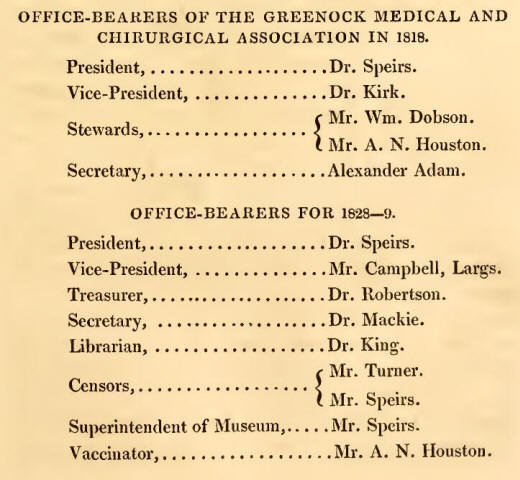 |

